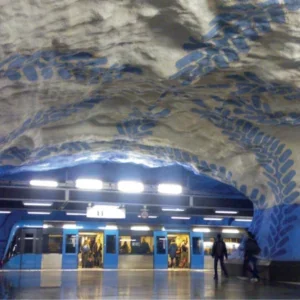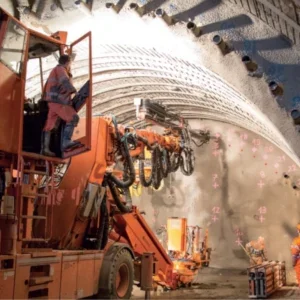The selection of pre-cast segmental lining necessitates a high level of advance planning unlike, for example, various forms of sprayed concrete linings that can be adapted easily to the actual ground conditions found during excavation. The design of segmental linings will be highly influenced by site investigations and will be uniform for long stretches of tunnel. The selected design must be able to cope with any range of ground conditions likely within the tunnel, plus a factor of safety. Site investigation information will consequently offer input to the planning of any special segment manufacturing facility, or better allow a third-party supplier to schedule its production.
Pre-cast linings generally form a circular tube for convenience of installation within TBM shields and to better handle the loading, assisted by annular grouting.
Despite the limited design and functional flexibility of pre-cast segmental lining, with correct and careful planning and preparation, the system offers great potential for project success in terms of cost control and construction uniformity. From design to installation the whole process can be treated as an industrial manufacturing operation. Most possible snags in the production process must be anticipated and prevented, or costs due to project delays can be substantial.
At most stages the collection of data, its interpretation and feedback into the system are of great importance. Computer systems with dedicated software are invaluable for these duties once the process is correctly understood and the desired results decided upon. Their involvement range from computer-aided design of the lining and segment moulds, to installation instructions and monitoring integrated into the TBM overall control system.
Moulds & segments
Many projects involving facilities for the local production of lining segments are now led by manufacturers of the necessary segment moulds, whether they also fabricate the necessary concrete batching and delivery plant themselves or buy it in. The moulds are designed and manufactured with the aid of 2-D and 3-D CAD/CAM software to make the segments capable of forming a lining ring to the required tolerances.
CBE, for example, produces more than 1000 segment moulds a year for segmental lining rings of 3-15m diameter. As well as being designed by computer, they are checked for dimensional accuracy in three dimensions using laser tracker instrumentation.
Concrete batching plants used for pre-cast tunnel segment production mainly follow general civil engineering practice. One manufacturer in this sector has become an example of the rise of China’s industry and economy as Milan-based CIFA was acquired by Zoomlion in September from the Magenta Fund. Changsha Zoomlion Heavy Industry Science & Technology Development Company is a leading construction equipment manufacturer in Asia. In tunnelling CIFA is known mainly for cast in situ formwork and concrete pumps as well as batching plants, but also supplies some segment moulds.
Specialist engineering designer and fabricator Marti Technics supplied segment moulds for the twin-bore Islisberg Tunnel on the Zurich Western By-pass. The moulds were used on Marti Tunnelling’s existing carousel units at its workshops. Marti Technics supplied three sets of six moulds including the keystone formwork.
Reinforcement & fibres
Another important aspect of segment design and manufacture is the type and fabrication of reinforcement. Traditional rebar ‘cages’ can now be made automatically with steel rod cutting and bending machinery before placing in the segment moulds.
Fibre reinforcement is rapidly gaining in popularity, especially when combined with more traditional reinforcement. The original function has been mainly to deter micro-cracking that can lead to bigger cracking and/or allow moisture into the concrete to corrode deeper-seated reinforcement. Perceived functional advantages have expanded in recent years and in some cases fibres can replace traditional reinforcement, with economic and production benefits. Materials costs have been an estimator’s nightmare as the high prices for steel and polymers of only a year ago are dropping significantly. Whilst this may sound good news, the inherent current cost instability makes planning difficult. Some steel manufacturing capacity has been reduced and one fibre manufacturer reports a forecast of slight cost rises in steel during early 2009.
As described in a recent report from the UK Concrete Society (Technical Report 63 – ‘Guidance for the design of steel-fibre-reinforced concrete’), the use of fibre reinforcement has enabled the number of segments in a designed lining ring to be reduced. While there are theoretical cost savings in not using reinforcement this results in other compromises such as the need for more segments to limit flexural stresses, including those caused during transport and handling. Excess stresses can also occur at segment joints or due to thruster rams, but these can be deterred by fibre reinforcement.
Steel fibres such as Bekaert’s Dramix and Propex Novocon varieties are now well established for use in pre-cast segmental lining as well as sprayed concrete linings. Some of the high-tensile, cold-drawn wire fibres have special profiles for better anchoring, and can be galvanised to protect against water-based corrosion if deemed necessary. For easier handling Bekaert’s Dramix fibres are supplied in lightly glued batches for break-up and dispersal during concrete mixing. A more recent high-tensile (at least 2000 N/mm2) version of Dramix fibres suits concrete strength of greater than C50/60, have an aspect ration of 80, and can be used as shear reinforcement. High performance efficiency and lower doses required offer cost reductions.
The Propex Novocon range of steel fibres includes FE flat-end fibres and HE hooked-end for heavy-duty use in anchoring the fibres when in tension. The Duoloc range of steel reinforcement fibres are manufactured by IFT Fasertechnik in a patented process. IFT also supplies its own dosing equipment in the Dino range.
Thicker synthetic fibres can perform structural functions as an alternative to steel, but with different characteristics. Propex’s HPP (High Performance Polymer) synthetic macro fibres are made from polypropylene. Elasto-Plastic Concrete (EPC)’s Barchip Shogun, Macro and Kyodo fibres are embossed throughout their length for better bonding with the concrete.
Other tunnelling uses for synthetic fibres such as Propex’s Fibermesh and EPC’s Barchip F are led by the need for fire protection, especially in transport and cable tunnels. The materials used are polymers and, for fire protection, are generally of fine monofilament diameter. On melting in a fire these create passages to relieve pore pressure. This has been shown to reduce the risk of concrete spalling.
Steel and ‘synthetic’ fibres are available in proprietary mixtures to offer a combination of optimum properties from both main types.
It is important that fibres are integrated into the concrete mix for pre-cast element production in a uniform way in correct quantities. Therefore metered dosing equipment is necessary. Such dosing equipment can be integrated into the controls of automated plant, providing increased productivity and quality.
Quality control
Many aspects of segment design and manufacture are specified by project consulting engineers, whilst it is widely recognised that other parameters have to be monitored, and, if possible, controlled in order to obtain best practice in segment manufacture and installation. All relevant Standards should be included in project specifications, but even if they are not, it is up to the segment manufacturer and contractor to comply with them.
In Europe the full list of construction Eurocodes were completed last year and will cause the withdrawal of any conflicting national Standards in EU member states from 2010. There is provision for including Nationally Determined Parameters on the basis of ‘local’ safety issues and there is a recognised need for further research into the use of certain materials and situations towards revised standardisation. Those standards including items of likely relevance to underground pre-cast segmental lining include Eurocode 2 – Design of concrete structures, Eurocode 4 – Design of composite steel and concrete structures and Eurocode 7 – Geotechnical design. Structural fire design is included in Parts 1-2 where relevant. In the UK further information is available through the new Eurocodes Expert website on www.eurocodes.co.uk or http://eurocodes.jrc.ec.europa.eu.
There are still no internationally recognised design codes dedicated to underground use, however, and procedures have to be based on available specialist research papers and guides as well as relevant parts of general construction codes and standards.
Monitoring and tests for values within design tolerances are commonly seen as the essence of quality control, but also essential is good practice to achieve the correct test results. Some of the activities that are crucial to product quality control are:
Good practice in manufacture:
1) Correct concrete mix batching within design tolerances and use with time limits of workability
2) Design and manufacture of moulds within design tolerances
3) Environmental conditions, or accelerated curing by steam ovens etc., within design limits for temperature, humidity, etc
4) Cleaning and oiling of moulds to ensure that no debris remains and demoulding takes place cleanly, to maintain the dimensional tolerances of the segments produced
5) Correct and careful demoulding, handling and stacking of segments
(see ‘Handling’ below)
Testing:
1) Foreman checks on good practice during manufacture
2) Monitoring of mould dimensions, preferably by high-capacity automatic system e.g. LaserTracker
3) Laser mensuration of produced sample segments (similar to above)
4) Test assembly of initial segment rings in factory to check design and correct assembly before problems on site
5) Structural testing of sample segments
Opinions vary on whose responsibility it is for dimensional quality control and what are acceptable tolerances, although there is a strong tendency to finer tolerances of even less than 1mm. Following the principles of industrial quality control it is apparent that all factors that could affect measurements should be taken into consideration that, in the case of pre-cast concrete, should include the stage of curing (and therefore shrinkage), ambient temperature, means of measurement, and what is actually being measured. In order to eliminate many variables, measurements should be taken at a fixed stage in the process sequence, and preferably under the more controlled conditions of a factory environment. Practically this stage should be between demoulding and fixing the gasket seal. In the case of segments a more comprehensive control of out-of-tolerance products may be obtained by measuring the production element i.e. the mould, rather than replying on sample measurements of the segments themselves. The latter would still serve as a check on sampled product quality although not as comprehensive as checking moulds.
Modern high-speed industrial instrumentation such as the Leica Laser Tracker and interferometer in this context is described in a paper – ‘Modern high precision high-speed measurement of segments and moulds’ – presented by VMT (Gesellschaft für Vermessungstechnik) staff to the 2006 ITA Congress in South Korea and other conferences that year. The software program TubGeo aids the evaluation of the many results to compare them with design values and tolerances.
Ram testing of sample concrete segments is carried out increasingly. In recent UK projects ram testing of Bekaert steel-fibre reinforced concrete segments has been carried out on the Docklands Light Railway (DLR) Woolwich extension, the Belfast sewer project and Croydon Cable Tunnel.
Segment handling
It is important to carry out careful handling and storage of segments during all stages from demoulding to ring erection at the TBM. In addition to any deficiencies in segment composition, poor handling is the greatest potential source of segment damage. As careful sequencing of segment delivery is usually practised, especially in curved drives, any loss of a segment due to damage can affect tunnelling progress disproportionally due to delays in tunnelling progress.
Correct handling is particularly important after casting when the segments will not be fully cured. Various devices have been developed, mainly by segment mould specialists, for steady lifting, linear transport and turning of the segments, sometimes combining more than one function.
In a recent project, the Hobson Bay sewer tunnel in Auckland, New Zealand, Ceresola TLS supplied specialist handling devices to Wilson Precast Construction of Papakura. These were part of an equipment list for a fully automated carousel line and moulds for the 3km-long drive.
Known mainly for its TBM back-up system but also now for many types of special equipment design and manufacture for underground use, Rowa produced two segment erection systems within hard-rock TBM back-up installations for Herrenknecht on the 10.75km long Wienerwald Tunnel. A major feature of the design is segmental lining rings of an exceptional 2.25m width to better match the performance of the TBM advance. The rings are erected without fasteners nor sealing and a cast in situ concrete sleeve applied inside to create an inner diameter of 9.65m from an excavation diameter of 10.6m. The back-up system incorporates many functions including the transport of in-situ concrete components and placement of the in-situ concrete, as well as pre-cast segment erection.
The construction of segments also has a bearing on their durability since there may be a tendency for corners to be removed or concrete to spall off reinforcement cages in the event of impact or other excess stress. Incomplete curing or poor composition would make this tendency worse. However, fibre reinforcement has been credited with minimising handling damage by making the segment structure tougher.
Installation
The use of trapezoidal designs of segments allows planned or correctional directional adjustments to be made by varying the positioning of the segments within the ring.
An important factor in successful installation is an appropriately designed gasket or seal between the segment joints. These are held in grooves around the perimeter of each segment and are made of various types of elastomer, depending on the application. They can be anchored in place as part of the segment casting process, or held in position with adhesive. Their function or functions can range from simply providing a cushion between segments to sealing against the ingress or egress of fluids and fines at certain pressures. They can be designed to tolerate an amount of lining movement due to ground pressure or tolerably inaccurate installation.
These functions are catered for by a wide variety of extruded profiles with different depths, widths and patterns of internal passages to allow compression whilst maintaining the seal. Advanced materials now used include hydrophilic polymers that expand in contact with water. Whilst these may create a better seal after a period in contact with water, they may not be so efficient in creating an effective seal soon after installation. For applications such as high groundwater pressure hydrophilic materials have been combined with more conventional compression seals such as in the Phoenix Evolution Seal.
Since its first tunnelling project in 1969, Phoenix has developed over 40 different cross-sections for more than 200 tunnelling projects. Sections are also custom-designed to specific design requirements
Daetwyler Rubber has been actively pursuing the current booming market in India for metro and water tunnels. The Delhi Metro Rail Corp (DMRC) has approved the use of its CoexSwell gaskets, which combine a conventional EPDM chambered seal with a hydrophilic profile. To gain approval all technical data has to be submitted in writing and afterwards explained in person. Thereafter the material has been cleared for use on subsequent projects.
Due to limited groundwater the lining being used in Delhi is designed for water pressures of 2-4 bar. The first metro in India to use Daetwyler products was line BC-18 including 6.4 km of underground route. The originally suggested standard segment joint profile 86-259 was replaced due to a high reaction force. Daetwyler developed a mono-EPDM seal with the maximum reaction force whilst successfully maintaining the required seal.
Final check
Once the ring is placed, activities such as annular grouting and possible ground pressure on the ring take place. Excess distortion of the lining must be avoided to negate current and later problems with installations made within the tunnel.
In order to check on possible ring convergence the VMT Ring Convergence Measuring System (RCMS) uses a series of inclinometers in a network for data collection by continuous monitoring. Checks on vertical ring movement can be incorporated using a reference prism. Accuracy is less than a millimetre and results can be integrated into the TBM guidance system and controls.
Other systems from VMT useful for checking correct installation include the Grout Pressure Sensor System (GPSS) that enables events such as grout setting time, complete ring coverage and natural ground pressure to be checked. In addition, the VMT GAPtrix replaces manual measurement and recording of tailskin clearance for input into the TBM Ring Management System. It employs a Leica DISTO with Bluetooth communication.
Segment production for the Islisberg Tunnel, showing reinforcement cages in moulds supplied by Marti Technics Cleaning segment moulds at contractor Morgan Est’s Ridham plant for the Croydon Cable Tunnel project






